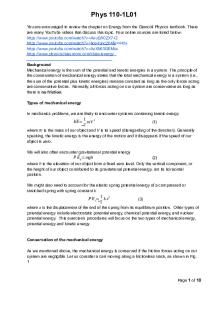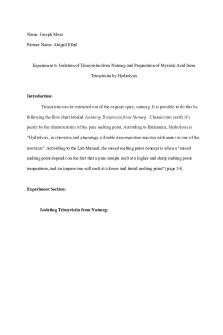Lab report 5 Ray Tracing PDF

| Title | Lab report 5 Ray Tracing |
|---|---|
| Course | Physics Lab II for Engineers and Scientists |
| Institution | University of New Orleans |
| Pages | 3 |
| File Size | 83.7 KB |
| File Type | |
| Total Downloads | 30 |
| Total Views | 156 |
Summary
Lab reports...
Description
LAB 5: Ray Tracing Michael Fernandez PHYS1065-003 Instructor: Joshua Veillon
Abstract/Theory: The purpose of this lab was to observe how light rays reacted with different surfaces, and mirrors. We use ray diagrams to see the index of refraction and reflection of visible light. We used different lens to see how the laser beams changed, to see if they converged or diverged. We then drew a diagram showing the refraction/reflection of light and then we can then use snell’s law to find the angle of refraction/reflection to get a more accurate picture of how the diagrams should look. This lab helped us better understand how light travels ad reflects/refracts.
Questions/Analysis: 1. A shark with a laser flashlight is pursing a flying fish at night. Use Snell’s law to find the critical angle of Incidence to the flashlight beam at the air-water boundary. Assume n=1.00 for air and n=1.33 for water. Snell’s law = N1Sin Ø1=N2Sin Ø2 So Assuming Sin1=90 degrees Sin2= (n1/n2)sin(90) Sin2=(1.00/1.33)sin(90) Sin2=0.7518; Arcsin Ø2=48.75 degrees 2. An object that is 1.0 cm tall is placed on a principal axis of a concave mirror whose focal length is 15.0 cm. The base of the object is 25.0 cm from the vertex of the mirror. Make a ray diagram with 2 or 3 rays that locate the image. Using the mirror equation, and the magnification equation, and the proper sign convention, calculate the image distance and the magnification. Is the image real or virtual? Is the image inverted or upright compared to the object? Is the image taller or shorter than the object? Mirror equation: 1/f=1/d0+1/di so 1/f-1/d0=1/di 1/15-1/25=1/di, so Di=37.5 cm Magnification =-((37.5)/(25))=-1.5 Image is Inverted. 3. An object that is 1.0 cm tall is placed on a principal axis of a concave mirror whose focal length is 15.0 cm. The base of the object is 10.0 cm from the vertex of the mirror. Make a ray diagram with 2 or 3 rays that locate the image. Using the mirror equation, and the magnification equation, and the proper sign convention, calculate the image distance and the magnification. Is the image real or virtual? Is the image inverted or upright compared to the object? Is the image taller or shorter than the object? Mirror equation: 1/f=1/d0+1/di so 1/f-1/d0=1/di 1/15-1/10=1/di, so Di= cm Magnification =-(()/(10))=- Image is Inverted.
4. A thin lens is made of crown glass (n=1.50). The radius of curvature for the first surface that an incident light ray encounters is 25.0 cm and this surface is bulging The second surface of the lens that light encounters is hollow and has a radius curvature of 20.0cm using the lens maker’s equation, and the proper sign convention, calculate the focal
length of this lens. Sketch a drawing of this lens, indicating its principal axis, principal focal point F’, and focal length f. 5. Why is the reflector behind the bulb in a flashlight ordinarily a parabolic mirror and not a spherical mirror? A spherical mirror does not reflect light as well as a parabolic mirror, a parabolic mirror takes the light, and amplifies, diverging and spreading the light out of the flashlight.
Conclusion: This lab helped us visualize better how different lens and lens shape interacted with rays of light. We saw how the direction of the lasers changed, and how some lens/mirror changed the beams or changed the angle of which they were at originally. This helps us understand more about how light travels, and what affects it and how. Using Snell’s law we are able to understand so much more as it tell us more about the relation between the angle of incidence and refraction and how it reacts as light passes through different materials/media....
Similar Free PDFs

Lab report 5 Ray Tracing
- 3 Pages

Ray tracing in Matlab
- 8 Pages

LAB 5 - Lab report
- 4 Pages

Lab Report 5 - lab
- 5 Pages

Ray-Optics-Lab - lab
- 11 Pages

Lab 5 - Lab report
- 6 Pages

Lab 5 - Lab experiment report
- 6 Pages

Lab 5 Lab Report- (Microbiology)
- 4 Pages

Phys lab 5 - Lab report
- 10 Pages

Experiment 5 - Lab Report 5
- 16 Pages

Post Lab Report Lab 5
- 5 Pages

Lab 5 Report
- 5 Pages

Chem lab report 5
- 7 Pages

Lab 5 Report
- 8 Pages

EX 5 lab report
- 10 Pages
Popular Institutions
- Tinajero National High School - Annex
- Politeknik Caltex Riau
- Yokohama City University
- SGT University
- University of Al-Qadisiyah
- Divine Word College of Vigan
- Techniek College Rotterdam
- Universidade de Santiago
- Universiti Teknologi MARA Cawangan Johor Kampus Pasir Gudang
- Poltekkes Kemenkes Yogyakarta
- Baguio City National High School
- Colegio san marcos
- preparatoria uno
- Centro de Bachillerato Tecnológico Industrial y de Servicios No. 107
- Dalian Maritime University
- Quang Trung Secondary School
- Colegio Tecnológico en Informática
- Corporación Regional de Educación Superior
- Grupo CEDVA
- Dar Al Uloom University
- Centro de Estudios Preuniversitarios de la Universidad Nacional de Ingeniería
- 上智大学
- Aakash International School, Nuna Majara
- San Felipe Neri Catholic School
- Kang Chiao International School - New Taipei City
- Misamis Occidental National High School
- Institución Educativa Escuela Normal Juan Ladrilleros
- Kolehiyo ng Pantukan
- Batanes State College
- Instituto Continental
- Sekolah Menengah Kejuruan Kesehatan Kaltara (Tarakan)
- Colegio de La Inmaculada Concepcion - Cebu
